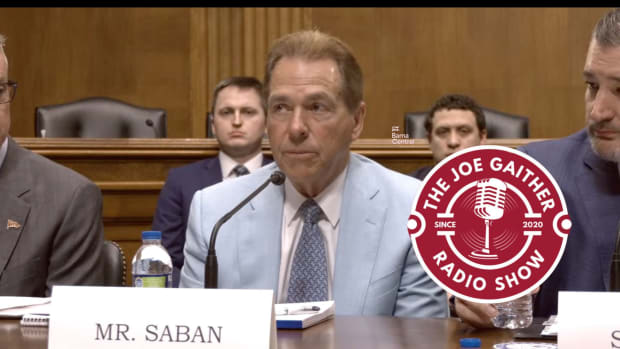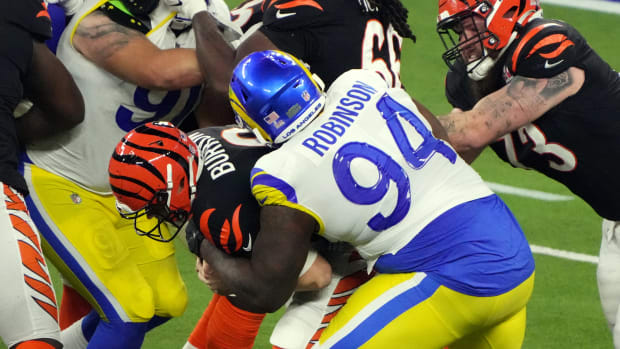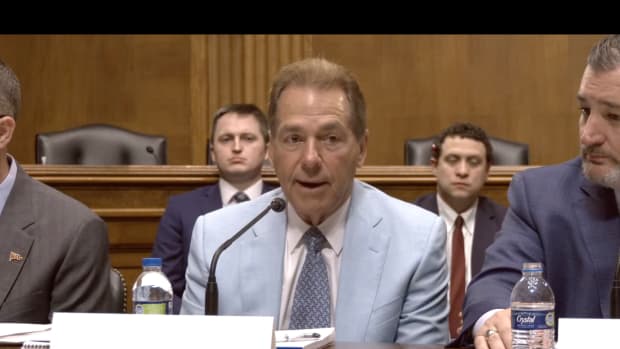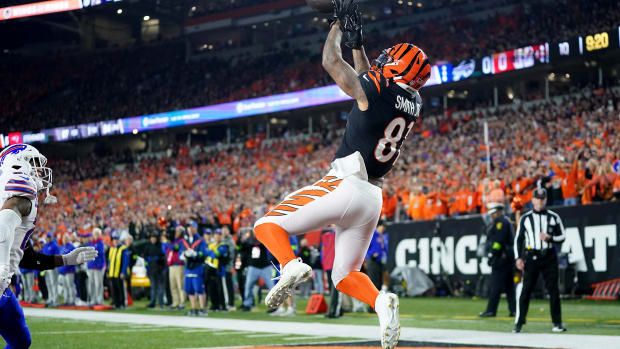Alabama's more methodical offense aims for less risk, greater rewards
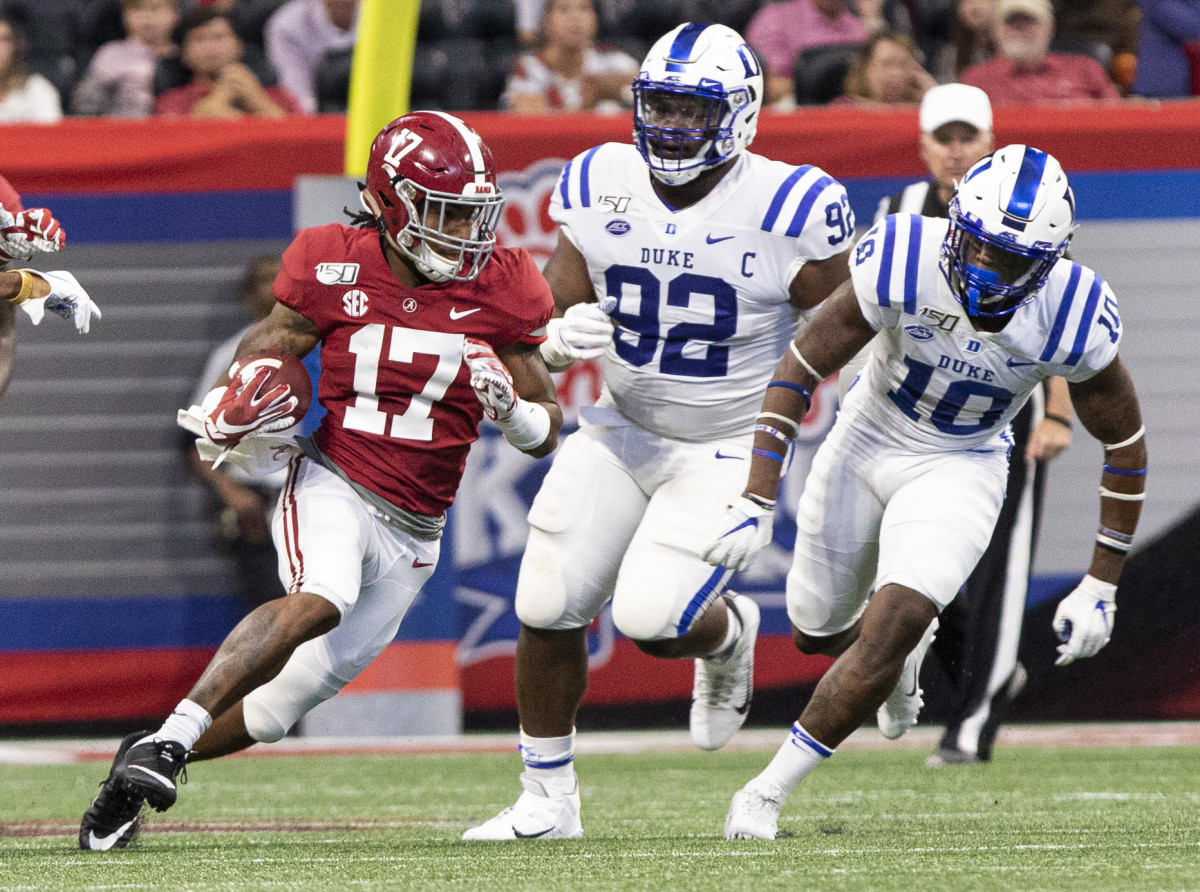
TUSCALOOSA, Ala. — It was off to the races.
Midway through the second quarter of Alabama’s season opener against Duke, when the Crimson Tide was establishing its dominance in the neutral-site game, Alabama had its biggest offensive play of the day.
It was a pass caught four yards behind the line of scrimmage. However, it turned into a39-yard catch-and-dazzle gain.
It would have been topped by running back Najee Harris taking another short pass 54 yards, but was nullified by a penalty. Regardless, the only thing missing from the Crimson Tide’s ability to gain yards after the catch were starting blocks.
“We don’t keep track of it,” junior wide receiver Jerry Jeudy said. “I feel like that’s what we do is make plays when we get the ball in our hands. You’ll know who is going to score. When we get the ball, we just try to make something happen.”
The players may not keep track of yards after the catch, but we do at BamaCentral. By our count, the Crimson Tide had 264 against the Blue Devils.
Jeudy topped the list:
Unofficial yards after the catch vs. Duke
Jerry Jeudy 82
Jaylen Waddle 66
DeVonta Smith 48
Miller Forristall 17
Henry Ruggs III 16
Brian Robinson 14
Jerome Ford 14
Major Tennison 7
Total: 264
To put that into some perspective, the most Alabama had all last season was 267 against Texas A&M.
However, what really jumps out is when one compares those totals to the 2018 averages of Alabama’s top receivers.
Average unofficial yards after catch, 2018 season
Jerry Jeudy 33.2
Henry Ruggs III 20.6
Jaylen Waddle 23.9
Irv Smith Jr. 24.4
DeVonta Smith 20.6
Let your playmakers make plays has always been a key part of Nick Sabans’ offense, regardless of how it’s done, and getting the ball to them in space is a key component of any successful offense nowadays.
So you can be certain that Saban knows exactly how many yards after the catch the Crimson Tide has every game.
“I always tell the players to take what the defense gives, that we can make explosive plays catching a 2-yard pass and turning it into a 70-yard play, as we can always trying to force the ball down the field,” Saban said. “Especially with the kind of players that we have that have run-after-a-catch ability. I think it’s imperative to the success of what we’re doing.
“But we’re also doing the things that we do because those guys can do that. It kind of lends itself both ways. We do it because they can do it and because they can do it, it’s a tremendous weapon.”
Alabama, of course, set numerous offensive records last season, and quarterback Tua Tagovailoa set the NCAA single-season record for passer efficiency.
That he did so while continually throwing down field is a big reason why he’s being hailed a potential top pick in the NFL draft. But those kinds of throws obviously come at a greater risk, which caught up to him some in the College Football Playoff.
Alabama still ran run-pass options (RPOs) against Duke. What Tagovailoa also did was read the defense better, not force bad passes and, as Saban said, take what the defense gave him. A huge benefit to doing so was Alabama ended up with a huge advantage in time of possession, 36:37-23:23.
“Not really,” junior wide receiver DeVonta Smith said when asked if there were fewer RPOs. “It was about the same thing, it was just the pressure that was coming in that stopped some of it.”
Under new offensive coordinator Steve Sarkisian, the real difference in the offense wasn’t with the plays necessarily, but when they were called. Sure there are new wrinkles, like four receiver sets. However, it’s not like Alabama didn’t have crossing routes and quick-release throws in the playbook before.
Also, Alabama also made an early adjustment, both to help out running back Jerome Ford, who had been thrust into the starting lineup, plus also counter Duke’s pass rush.
“That’s the whole thing with football, you have to make adjustments in games and that’s something we had to adjust to,” Smith said. “I mean, that wasn’t something that was planned, it just happened.”
Consequently, a huge problem for defenses is that even though Alabama may not be looking to go deep as much, it still can. All of last season proved that, and even at SEC Media Days Tagovailoa was still talking about taking shots downfield.
The threat will be enough.
Tagovailoa chucked only one ball down field against Duke, early in the game when he overthrew Jeudy. Otherwise, his longest throw downfield was just 23 yards, also an incompletion. It was when Duke was in man coverage, and he tried to do a pump fake and then hit sophomore wide receiver Jaylen Waddle on the right side.
Alabama probably won’t be seeing too much man coverage this year, mostly zone against its high-flying receivers.
Of Tagovailoa’s 31 attempts, 25 were 10 yards downfield or shorter. Of those, there was just one incompletion, the quick throw left in which Jeudy wasn’t expecting the pass.
Seven of his throws were to someone behind the line of scrimmage, by Waddle.
They resulted in 91 yards and a touchdown.
“I feel like we were more play-by-play,” Jeudy said. “You know, last year we were more like score fast, score fast, big play, score fast. This year, we’re like taking it slow play-by-play. I feel like that was just us the first half, but the second half we did a lot better on taking advantage of our plays."


